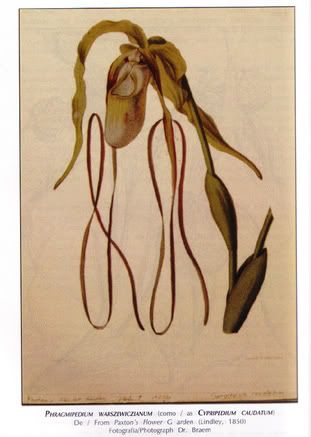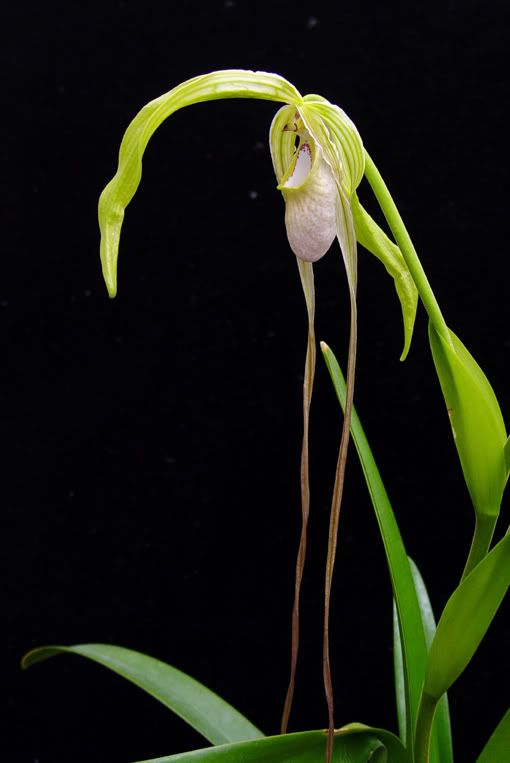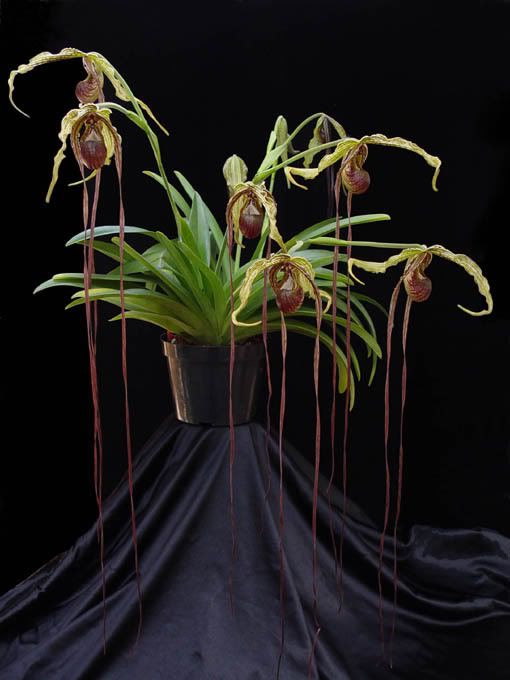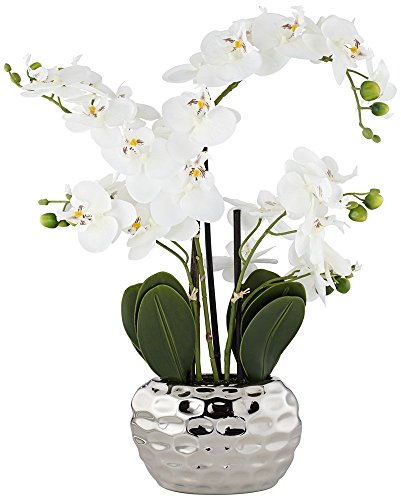D
Drorchid
Guest
OK, I want to start a debate regarding the group of Phragmipediums with long Petals. As some of you may know myself, Dr. Guido Braem and Sandy Ohlund wrote some articles regarding these species.
In a nutshell, Guido discovered that what we have been calling Phrag. wallisii all these years was an incorrect name. The reason is that Reichenbach who gave the name Phrag. wallisii in 1873 to that species, had named the same species twice. Twenty years earlier he had also described and named the following species (shown in the following picture, depicted in Paxton's Flower Garden (Lindley, 1850):

The name he gave to this species is Phrag. warscewiczianum. This was a species native to South America. This is clearly what we nowadays have been calling Phrag. wallisii.
see picture:

This means that if you follow the International Code, as the name Phrag. warscewiczianum was used first, this is the official name for this species, and Phrag wallisii becomes invalid.
Now later, in the trade another species showed up, that was native to Central America (Panama and Costa Rica). This is the following species:

Guido found out that this species was never officially described, but for some reason in the past it got the name Phrag. warscewiczianum associated with it. As this name was already taken by a different species we decided to officially describe it and give it the name Phrag. popowii.
Now my question for you guys is the following: It is clear there are 5 different (that we know of ) taxa within this group. We decided to give all 5 the species rank. So we came up with:
1. Phrag. caudatum
2. Phrag. lindenii
3. Phrag. warscewiczianum
4. Phrag. popowii
5. Phrag. exstaminodium
It was clear to us that Phrag. lindenii and Phrag. warscewiczianum are more closely related than to the other species, and the same is true to the two Central American species, Phrag. popowii and Phrag exstaminodium, but we decided to keep them as separate species, as we felt that they were isolated populations that grew in different areas and thus far we know no gene flow was occurring from one population to the next. I talked to a botanist (I forgot what his name is at the moment) who worked at the University in Ecuador, and he has seen Phrag. lindenii in the wild. According to him Phrag. lindenii grows in very different locations than Phrag. warscewiczianum and according to him they were 2 distinct species. Also it made it cleaner.
Cribb and Dressler on the other hand want to divide this group into 3 species. According to them lindenii is a "mutant" form of warscewiczianum, as it is bascally the peloric form of this species (It has 3 petals instead of a pouch). Aslo exstaminodium is the "mutant" form of popowii. It lacks the staminodal shield and just like Phrag. lindenii it self pollinates. However as lindenii was described before warscewiczianum and exstaminodium was described before popowii, the "mutant" forms would become the species names, and you would get the following classification (They probably would give them different variety names, but I gave them the same variety name to make it more clear):
1. Phrag. caudatum
2a. Phrag. lindenii var. lindenii
2b Phrag. lindenii var. warscewiczianum
3a Phrag. exstaminodium var. exstaminodium
3b Phrag. exstaminodium var. popowii
The third thing you can do is to call it all the same species (Phrag. caudatum) and have 5 different varieties:
1a Phrag. caudatum var. caudatum
1b Phrag. caudatum var. lindenii
1c Phrag. caudatum var. warscewiczianum
1d Phrag. caudatum var. exstaminodium
1e Phrag. caudatum var. popowii
Now my question to you guys is which classification to you prefer and why? Scenario one with 5 species; scenario two with 3 species and 2 varieties, or scenario three with one species and 5 varieties?
Robert
In a nutshell, Guido discovered that what we have been calling Phrag. wallisii all these years was an incorrect name. The reason is that Reichenbach who gave the name Phrag. wallisii in 1873 to that species, had named the same species twice. Twenty years earlier he had also described and named the following species (shown in the following picture, depicted in Paxton's Flower Garden (Lindley, 1850):

The name he gave to this species is Phrag. warscewiczianum. This was a species native to South America. This is clearly what we nowadays have been calling Phrag. wallisii.
see picture:

This means that if you follow the International Code, as the name Phrag. warscewiczianum was used first, this is the official name for this species, and Phrag wallisii becomes invalid.
Now later, in the trade another species showed up, that was native to Central America (Panama and Costa Rica). This is the following species:

Guido found out that this species was never officially described, but for some reason in the past it got the name Phrag. warscewiczianum associated with it. As this name was already taken by a different species we decided to officially describe it and give it the name Phrag. popowii.
Now my question for you guys is the following: It is clear there are 5 different (that we know of ) taxa within this group. We decided to give all 5 the species rank. So we came up with:
1. Phrag. caudatum
2. Phrag. lindenii
3. Phrag. warscewiczianum
4. Phrag. popowii
5. Phrag. exstaminodium
It was clear to us that Phrag. lindenii and Phrag. warscewiczianum are more closely related than to the other species, and the same is true to the two Central American species, Phrag. popowii and Phrag exstaminodium, but we decided to keep them as separate species, as we felt that they were isolated populations that grew in different areas and thus far we know no gene flow was occurring from one population to the next. I talked to a botanist (I forgot what his name is at the moment) who worked at the University in Ecuador, and he has seen Phrag. lindenii in the wild. According to him Phrag. lindenii grows in very different locations than Phrag. warscewiczianum and according to him they were 2 distinct species. Also it made it cleaner.
Cribb and Dressler on the other hand want to divide this group into 3 species. According to them lindenii is a "mutant" form of warscewiczianum, as it is bascally the peloric form of this species (It has 3 petals instead of a pouch). Aslo exstaminodium is the "mutant" form of popowii. It lacks the staminodal shield and just like Phrag. lindenii it self pollinates. However as lindenii was described before warscewiczianum and exstaminodium was described before popowii, the "mutant" forms would become the species names, and you would get the following classification (They probably would give them different variety names, but I gave them the same variety name to make it more clear):
1. Phrag. caudatum
2a. Phrag. lindenii var. lindenii
2b Phrag. lindenii var. warscewiczianum
3a Phrag. exstaminodium var. exstaminodium
3b Phrag. exstaminodium var. popowii
The third thing you can do is to call it all the same species (Phrag. caudatum) and have 5 different varieties:
1a Phrag. caudatum var. caudatum
1b Phrag. caudatum var. lindenii
1c Phrag. caudatum var. warscewiczianum
1d Phrag. caudatum var. exstaminodium
1e Phrag. caudatum var. popowii
Now my question to you guys is which classification to you prefer and why? Scenario one with 5 species; scenario two with 3 species and 2 varieties, or scenario three with one species and 5 varieties?
Robert
Last edited by a moderator:









































